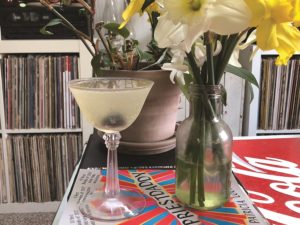I’ve had my nose in the books. I spent this winter dragging the first draft of a food memoir out of the dish pits of my mind. As a counterpoint to that introspection, I’m trying to help with a sweet community cookbook on the side.
Recently, I mentioned to the group the idea of breaking that book into seasonal volumes. Their eyes seemed to focus on something far past the walls of the room, and one of them verbalized the general confusion: “Seasonal how?”
Occasionally, I have to be reminded that many people do not think about food as a job, a form of recreation, or a means of survival. For me it is all these things, all year round. The seasons are something I negotiate with, both for their gifts and the limitations they impose.
Maybe you don’t scan the produce company’s weekly report, maniacally hoping to catch the tiny allotment of spring ramps, or Vidalia onions, or white asparagus before they sell out, so spring may not register on you as a time for edible celebration. But my obsession with ingredients has been a lifelong affliction and privilege.
I have, however, this spring, come to envy folks with the extra room in their brains for information about anything other than what the next chapter is about. This writing project threatens to put a crimp in my fixation on eating at least one thing I love every day. Right now, it’s all I can do to keep us fed, period. I’ve resorted to a kind of cooking ease that I’ve always aspired to but used to overcomplicate.
Now I’m making things like “whatever leftover vegetables there are” stuffed into an omelet with soft cheese. Or frozen pizza with “a green thing” beside it. Or my recent favorite, a piece of toast “with food on it.” That might be a single piece of buttered toast, topped with hummus and vegetables, or avocado and cheese, or scrambled eggs with salami.

It’s been liberating but hasn’t inspired the kind of seasonal revelation I want to be sharing with you here. For that, we’re going to turn to the bar, and a spring delight that is accessible to everyone: flowers. The daffodils are in such resplendent bloom, finally, that I have two bouquets inside, in addition to the full beds in the garden. The hyacinth and tulips have poked up; they’re next on stage. There will be peonies and roses soon, and in anticipation of this blessed annual antidepressant, we’re going to drink a drink that some folks think tastes like a mouthful of flowers.
If that thought repels you, move along, there is no convincing you into this one. Celebrate spring another way.
The Aviation was the first gin cocktail I ever loved, helped along by the fact that lemon juice and violets are two of the other loves of my life. This cocktail has been on a popularity roller coaster over the last few decades — finding itself in demand during the first suspendered-bartender-craft-cocktail rush, then abruptly out of fashion again when we all went back to simpler classics.
You need nothing fancier than Beefeater for the gin, unless you feel like showing off. The maraschino liqueur (I like Luxardo best) is nonnegotiable — without it, this is a completely different cocktail. Although maraschino is distilled from Marasca cherries, it is neither red, nor particularly sweet; instead, it imparts the tannic and floral flavors of cherry skins and stems. The violet can come from either Crème de Violette (which is bright purple) or Crème Yvette (a more delicate balance of violets, blackberries, raspberries, and currants with a slightly less neon hue).
Measurements on these liqueurs, while always important in cocktail making, are especially crucial here. As beloved cocktail historian David Wondrich said, the Aviation can slip easily into the territory of tasting like “fancy hand soap.” When the balance is correct, this is a bright, bracing, floral celebration of the ground awakening after a long winter.
The Aviation
for one cocktail
2.5 oz. gin
½ oz. lemon juice (squeeze it fresh or don’t bother)
1.5 bar spoon* maraschino liqueur (I use Luxardo)
1 bar spoon Crème Yvette or Crème de Violette
Lemon twist or brandied cherry to garnish
Put all ingredients except the garnish into a cocktail shaker and fill with cracked ice. Shake until the outside of the shaker gets frosty — at least 10 seconds longer than you think. Strain into a chilled coupe, garnish with a lemon twist or cherry, or both if you’re feeling saucy.
* If you don’t have one, a bar spoon holds about the same volume as a teaspoon. But barspoons are indispensable for measuring and stirring cocktails — I couldn’t live without mine.



